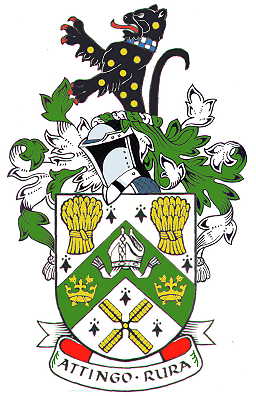Thingoe: Difference between revisions
Knorrepoes (talk | contribs) m (Text replace - "|}<seo title="Crest, Arms, Coat of Arms, Heraldry />" to "|}<seo title="Crest, Arms, Coat of Arms, Heraldry" />") |
Knorrepoes (talk | contribs) m (Text replace - "[[Literature" to "{{media}} [[Literature") |
||
| Line 22: | Line 22: | ||
The ounce is derived from the crest and supporters of the Marquesses of Bristol and is used nowhere else in civic heraldry. His collar of white and blue is that which decorates the crest and supporters of the Dukes of Grafton. The crest alludes to all the old local families through their two highest ranking representatives. | The ounce is derived from the crest and supporters of the Marquesses of Bristol and is used nowhere else in civic heraldry. His collar of white and blue is that which decorates the crest and supporters of the Dukes of Grafton. The crest alludes to all the old local families through their two highest ranking representatives. | ||
{{media}} | |||
[[Literature]] : Image and information provided by Laurence Jones and from [http://www.civicheraldry.co.uk here]. | [[Literature]] : Image and information provided by Laurence Jones and from [http://www.civicheraldry.co.uk here]. | ||
Revision as of 06:44, 9 July 2014
| Heraldry of the World Civic heraldry of the United Kingdom |
THINGOE (rural district council)
Incorporated into: 1974 Saint Edmundsbury
Official blazon
Arms : Ermine on a Chevron Vert between in chief two Garbs of Barley and in base the Sails of a Windmill saltirewise Or a Mitre Argent between two Ancient Crowns each enfiling as many Arrows points downward in saltire Gold.
Crest : On a Wreath Argent and Vert a demi Ounce Sable bezantée gorged with a Collar counter-company Argent and Azure.
Motto : 'ATTINGO RURA' - I manage the countryside
Origin/meaning
The arms were officially granted on February 20, 1958.
The green chevron represents the "Thing-hoe" or " assembly-hill" from which the ancient hundred and Rural District took their names. The white abbot's mitre and two of the gold crowns and arrows of St. Edmund, represent the ecclesiastical history of the district in its close association with Bury Abbey and Ixworth Priory. The two sheaves of barley are for the chief industry of the district, agriculture; this is further represented by the windmill sails in the base, alluding to familiar landmarks of this part of Suffolk, especially that at Pakenham. The ermine background is an allusion to the district's royal connections, including many royal visits during the Tudor and Stuart periods and in more recent times.
The ounce is derived from the crest and supporters of the Marquesses of Bristol and is used nowhere else in civic heraldry. His collar of white and blue is that which decorates the crest and supporters of the Dukes of Grafton. The crest alludes to all the old local families through their two highest ranking representatives.
Contact and Support
Partners:
Your logo here ?
Contact us
© since 1995, Heraldry of the World, Ralf Hartemink 
Index of the site
Literature : Image and information provided by Laurence Jones and from here.










